How to Play Poker: Winning Strategy for Beginners
To start your poker journey, you should first focus on mastering the fundamentals of poker. You will not only learn the rules of poker and the hand rankings but also the strategies necessary to become a solid winning poker player. For this guide on how to play poker, we will focus on Texas Hold’em, which is the most popular variant of poker currently played live and online and in major tournament series around the world.
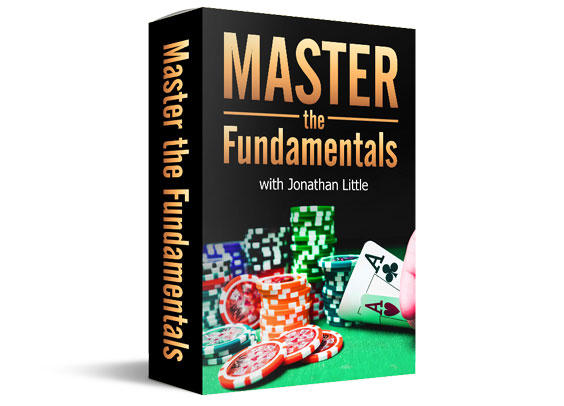
Poker Rules of No-Limit Hold’em
Poker is an exciting game that requires constant dedication in order to improve your skills. The good news is that the basic poker rules are easy to learn, and once you learn the fundamentals, you will start to have a real grasp of the game.
No-Limit Hold’em, the most popular poker variant, is played with one 52-card deck and no jokers. A poker game consists of playing hands using the chips and the cards available to you. Your main goal in each hand is to win the pot, which is the money all players are betting.
You win the pot if you either:
- Make everyone else fold before the showdown
- Make the best hand at the showdown
Showdown: when all betting rounds are complete and all
remaining players compare their hands.
To start off a poker game, each player receives a chip stack, which is used for the betting rounds. At the start of every hand, the dealer shuffles the deck and gives each player two hole cards, face down. The player to the immediate left to the dealer posts the small blind, and the player left to the small blind posts the big blind.
Blinds: the small blind and the big blind are two forced
bets that are the first money in the pot. They ignite the
action from other players.
After the hole cards are dealt, the first betting round takes place. This first betting round is called preflop.
In No-Limit Hold’em, there are four rounds of betting:
- PREFLOP: first two private hole cards
- FLOP: three shared community cards
- TURN: one shared community card
- RIVER: one shared community card
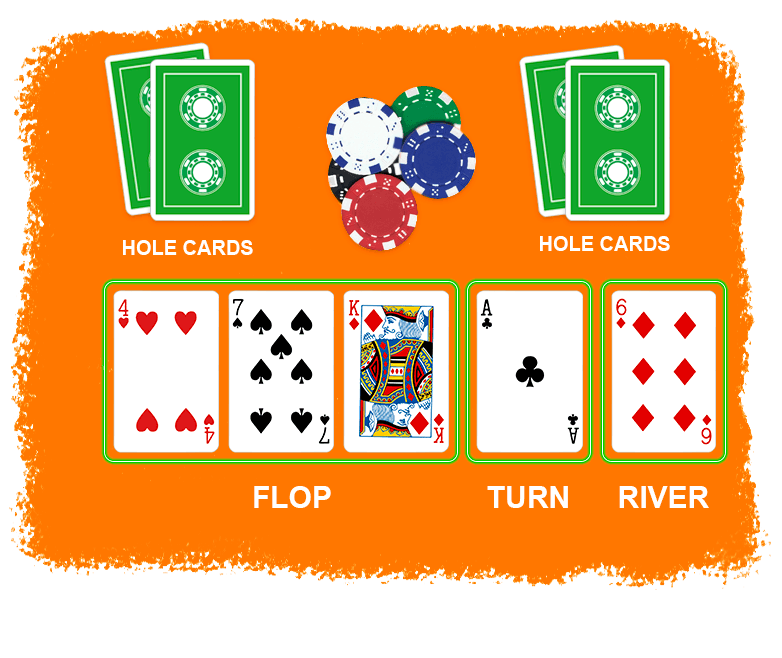
If you decide the cards you were dealt are not worth calling the bets that your opponents make and you don’t want to continue in the hand, you can fold your cards and you are out. Once you fold, you can no longer win the pot.
Fold: when you decide not to remain in the hand and throw your cards away
The board is now complete and the players who remain in the hand now make their best possible 5-card hand with a combination of the community cards and their hole cards. Then, they compare their best 5-card hand with their opponents’ hands to see which player has the highest ranking poker hand. This is called the showdown. The best hand wins the pot.
Once a poker hand is finished, the dealer gives the pot to the winner. The dealer button then moves on clockwise to the next player, as do the blinds, for the start of the next hand.
Watch Jonathan Little below demonstrate two sample poker hands:
Poker Hand Rankings
Now that you understand the basic flow of a poker hand, the very next thing you need to learn is which hand wins at the showdown. Learning the poker hand rankings will help you make decisions throughout the game.
You make a hand using the best 5 cards at your disposal, using the cards in your hand (hole cards) combined with the community cards. Suits all rank the same, but some hands rank higher than others.
From high to low, these are the poker hands you try to make during a game:
Royal Flush
The ultimate golden nugget! You hit a Royal Flush when you get Ace, King, Queen, Jack, and 10 of the same suit. A Royal Flush is the strongest and rarest hand in Texas Hold’em. Can’t beat that!
Straight Flush
A straight flush is when you gather 5 consecutive cards of the same suit.
Four-of-a-kind also known as Quads
4 cards of the same rank and a fifth card of a different rank. The best Quads combination is 4 Aces and a King of any suit.
Full House, also known as a Boat
A combination of three of a kind and a pair: three cards of the same rank and two other matching cards of a different rank. An example of a full house is 9♣️9♦️9♠️4♣️4♦️.
Flush
Any 5 cards of the same suit. Say you’re holding K♥️J♥️ and the board comes 4♥️5♥️2♥️. You then have a King-high flush.
Straight
5 consecutive cards of any suit. Example: Q♥️J♣️10♥️9♦️8♦️ and 5♦️4♣️3♦️2♥️A♣️
Three-of-a-kind or Trips
A hand made of 3 cards of the same rank plus two unmatched cards. 8♥️8♣️8♥️J♦️Q♦️ or 2♦️2♥️2♣️10♥️10♦️ are both three-of-a-kind hands, but the first one is higher in rank and beats the latter because an 8 is higher than a 2.
Two Pair
2 different pairs in the same hand plus another unmatched card. With K♣️K♥️9♦️9♥️10♦️, you have a pair of Kings and a pair of Nines.
Pair
Any 2 cards of the same rank plus 3 unmatched cards. 4♦️4♥️K♣️J♥️9♦️ is a hand with a pair of fours. 7♣️7♥️9♦️8♦️4♥️ is a hand with a pair of sevens.
High Card
When you miss the board and don’t even hit 2 cards of the same rank. It’s the lowest-ranking hand, but you can still win the pot by having a higher card than your opponent.
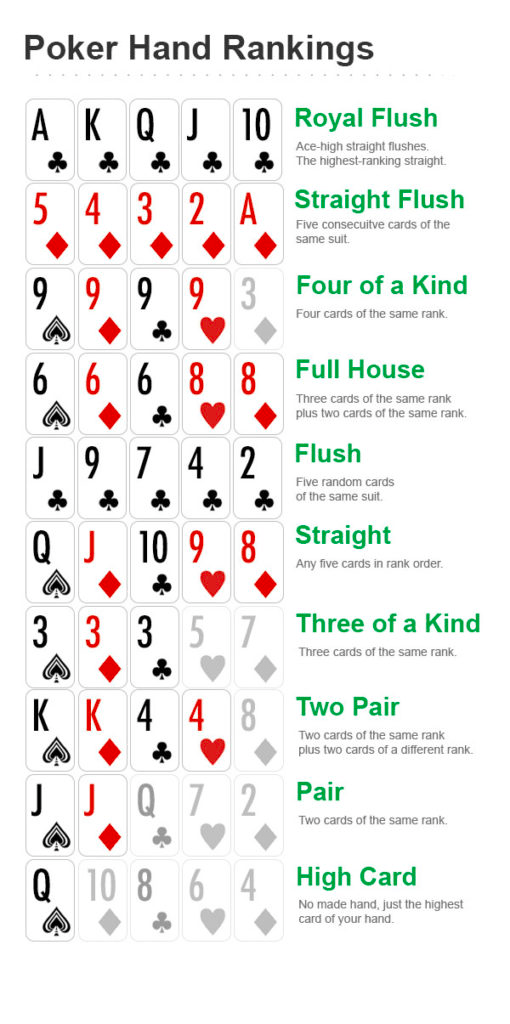
Now, let’s see if you understand how these poker hand rankings work:
Compare your best 5-card hand to your opponent’s hand to see who wins this pot:
You hold 7♠️5♣️ and the board is A♣️4♠️6♦️Q♦️8♥️.
Your opponent shows Q♠️Q♣️ at the showdown.
Which hand wins the pot at showdown?
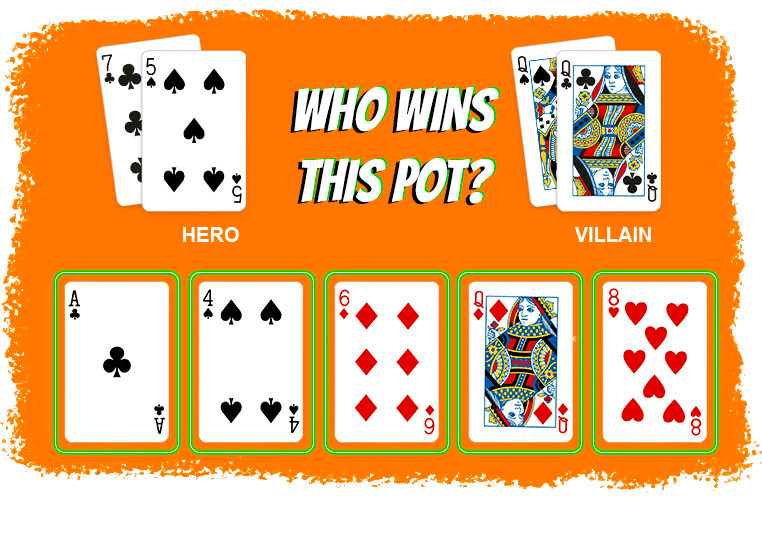
With this board, your final best 5-card hand is 4♠️5♣️6♦️7♣️8♥️, a straight. Your opponent’s best 5-card hand is Q♠️Q♣️Q♦️, three-of-a-kind.
A straight beats a three-of-a-kind, so YOU WIN this pot at showdown.
Want more examples? Watch the video below to learn more about poker hand rankings:
Can You Have a Tie in Poker?
More often than you think! A tie in poker means that two or more players have hands with the same rank value at showdown. If that happens, the highest top card determines the winner of the pot. If the players manage to have the same highest card, the second-highest card determines the winner and so on.
For straight or flush ties, the highest top card wins the hand. When players tie with four-of-a-kind, three-of-a-kind, two-pair, one-pair or high-card hands, the highest kicker (side card) wins:
FULL HOUSE OVER FULL OVER
J♥️J♣️J♦️2♥️2♣️ beats 2♥️2♣️2♦️J♥️J♣️
FLUSH OVER FLUSH
K♥️J♥️10♥️8♥️4♥️
beats
Q♥️J♥️10♥️8♥️4♥️
ranking card than a Queen.
STRAIGHT OVER STRAIGHT
J♣️10♥️9♦️8♣️7♠️
beats
10♥️9♦️8♣️7♠️6♥️
ranking card than a 10.
TRIPS OVER TRIPS
J♥️J♠️J♦️3♥️2♥️
beats
3♥️3♠️3♣️J♥️2♥️
ranking card than a 3.
TWO-PAIR
A♣️A♥️2♦️2♣️3♠️
beats
J♥️J♦️4♦️4♣️3♠️
ranking card than a Jack.
ONE-PAIR
3♥️3♠️6♦️5♥️K♥️
beats
2♥️2♠️3♠️A♥️K♥️
ranking card than a 2.
HIGH-CARD
Q♣️J♥️8♦️6♣️5♠️
beats
J♥️10♦️8♦️6♣️5♠️
ranking card than a Jack.
If all five cards are of the exact same rank, the pot is split between the players.
In the beginning, it may seem like a lot of information, but you will eventually get a hang of this with practice!
Effective Stack Size
In many movies and tv shows, whenever there’s a poker game, we often see the players taking money out of their pockets in the middle of a hand and adding that to their bet. In return, you will see another player grab their car keys out of their pockets and toss them into the pot. No long after that, you’ll find them betting their wedding rings and the deeds to their farms when they run out of cash.
It makes for great tv, but that’s not how poker works in real life. You can only lose the money that you have in front of you. That means that if you’re sitting at a poker table with $100 dollars and your opponent has $10,000 dollars, the most you can win from them is $100, and the most they can win from you is also $100. Now, if you win a hand for all your money and go from $100 to $200, the maximum amount you can win or lose goes up to $200. That means that we are always essentially playing the shortest of the stacks involved in the pot — and that’s your effective stack size.

Calculating How Many Big Blinds You Have In Your Chip Stack
You also want to calculate the stacks in play in terms of big blinds. This will help you get an idea of whether you are playing deep-stacked, medium-stacked or short-stacked. The poker strategy you choose to use in the game changes according to the size of your stack, so it’s important to keep this in mind.
Poker Stack Sizes
Short-stacked: 25 big blinds or fewer.
Medium-stacked: 26 – 50 big blinds.
Big-stacked: 51 – 100 big blinds.
Deep-stacked: 101 big blinds or more.
Poker Stack Sizes
25
Short-stacked
50
Medium-stacked
100
Big-stacked
200
Deep-stacked
To calculate big blinds, you need to divide the total amount of chips in your stack by the current big blind level.
With 10,000 chips at 100/200 blinds you have: 10,000/200 = 50 big blinds
With 10,000 chips at 100/200 blinds you have: 10,000/200 = 50 big blinds
Note that just because you have a lot of chips in front of you, it doesn’t mean you are playing deep-stacked. That is because your stack is tied to the blind level:
With 1,200,000 at 50,000/100,000 blinds, you have: 1,200,000/100,000 = 12 big blinds
Preflop Strategy
That’s the poker strategy for the first betting round of a poker hand. This is the first street of poker and also the most played one, and it’s vital to know if you want to continue or not after looking at the cards you were dealt. For this, we’ll start by giving you a quick look at the best and worst starting hands in poker.
The Best Starting Hands in Poker
The best starting poker hands are considered to be the strong big pairs, such as AA, KK, QQ, JJ or TT, or the hands that have the potential to make an incredibly premium hand, like a flush or a straight.
AK, AQ, AJ, KQ are hands that have the potential to make a really big pair with a strong kicker.
Medium pairs are strong enough to sometimes be the best hand at showdown, but they also have the potential to make a three-of-a-kind, which is usually a winner.
Suited Aces are particularly good because whenever you make a flush, you have the best possible one, also known as the nut flush.
Suited Connectors such as 9♣️8♣️, J♦️9♦️, and 9♥️7♥️ are pretty strong, because they can make flushes, straights and decent middle pairs that are reasonable poker hands to have at showdown.
| The Best Hands In Poker | Example |
|---|---|
| Big Pocket Pairs | K♣️K♠️ |
| Strong Big Cards | A♣️Q♠️ |
| Medium Pocket Pairs | 8♥️8♠️ |
| Suited Aces | A♦️8♦️ |
| Suited Connectors | 8♠️7♠️ |
| Weak Pocket Pairs | 3♣️3♥️ |
At last, we have Weak Pocket Pairs, pairs made from 2s to 6s. While not being notably premium poker hands, when they do make three-of-a-kind, you just hit gold.
Keep in mind that just because you were dealt a premium hand, it doesn’t automatically mean that you should play that hand. Let’s take for example, A♣️T♣️. If there are many bets placed before your turn, your hand might not be that strong anymore. Also, low Suited Connectors, such as 4♦️3♦️, aren’t actually that good because their best potential hands are usually low flushes and low straightsthat can lose to higher flushes or straights.
The Worst Starting Hands in Poker
These are the poker hands you will hardly ever want to play. Junky Connected Cards such as 8♥️6♣️, 8♣️4♦️, 7♥️5♦️ are deceiving. These hands may look playable at first because you have the potential to make a straight, but keep in mind that you don’t actually make a straight all that often. Mostly, you will have a bad pair and a bad kicker when you connect with the board. Junky Suited Cards follow the same principle, as you don’t hit a flush all that often.
Don’t fall for Big and a Little Card hands either: you will often be dominated by stronger hands from your opponents.
| The Worst Hands In Poker | Example |
|---|---|
| Junky Connected Cards | 8♠️6♥️ |
| Junky Suited Cards | J♦️3♦️ |
| Big and Little Cards | Q♥️2♠️ |
| Unconnected Low Cards | 8♣️2♦️ |
Relative Poker Hands Strength
Some new poker players have a difficult time with the idea of poker hand rankings because they like to think that specific types of hands, like three-of-a-kind, are always equally strong. That’s definitely not the case. It’s imperative to realize that poker hand values change depending on board texture and how many players you are against.
Board Texture: how the community cards interact with hand
ranges and their potential to make hands
To understand how some hands would stack against each other, watch this video where Jonathan Little goes through a few starting hands and help you to decide which poker hands you should choose to play:
Three Main Reasons to Bet In Texas Hold’em
Now that you know which hands you want to play preflop, let’s look into why you will initiate a poker bet. Keep in mind that these reasons apply to all betting rounds. Here are the three main reasons to bet in Texas Hold’em:
Value
You bet because you want worse poker hands to call. You want to value-bet with a premium hand or a decent, but marginal hand. Whenever you value-bet, make sure that worse hands can realistically call your betting amount.
Protection
You bet because you want poker hands that have the potential to improve to fold. Let’s say you make a low top pair with a marginal kicker. You bet because your hand is probably best but your opponents have hands with the potential to outdraw it on later streets, and you want those hands to fold.
Bluff
You bet because you want better hands to fold. Preflop, if you bet hands at the bottom of the range of hands you are willing to play, they are considered to be bluffs. If you bet knowing that when your opponent calls that you always lose, that’s a pure bluff. This usually happens on the last betting round, the River. A semi-bluff is when you choose to bet with a hand that still has a chance to improve on later streets if you get called, such as with a straight or flush draw.
Now, the betting strategy you choose widely varies depending on how many players are still in the hand. We’ve separated a few different preflop strategies for you to learn in our Master the Fundamentals Premium Course. You’ll learn detailed strategies on how to proceed with a hand when everyone folds to you, when you get 3-bet, when you only face limpers, when someone raises before you, and when there is a lot of action.
Range: the combination of hands a player may possibly be holding at any time. Putting your opponents on a hand range instead of one specific hand is crucial for determining your best playing strategy.
As an example, when you face a preflop raise from an UTG opponent, you should start thinking of what hands they might have in their range. If you look at this preflop chart on the right, it shows you some possible combinations of hands they’d be raising with a stack of 15BBs.
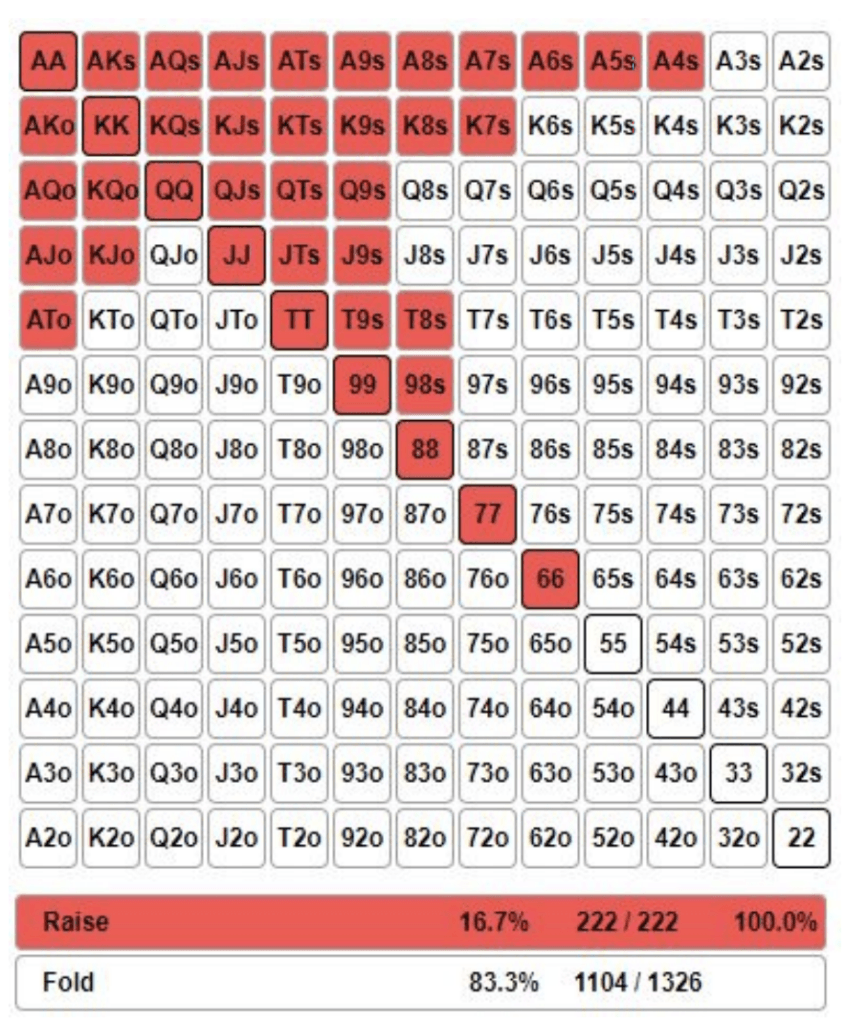
Postflop Strategy
That’s the poker strategy you use after the first three community cards come. Postflop strategy is a huge topic and it may be a bit overwhelming at first, but we’ve created a lot of poker quizzes and challenges on PokerCoaching.com for you to test how much you’ve absorbed the content as you study along.
Let’s start off by presenting some must-learn concept that will heavily dictate your postflop play. When you get to the flop, you essentially want to ask yourself if your next step will be to check or to bet, and then, how much to bet if you decide to. Choosing when to bet and the betting amount is determined by three main concepts:
Range Advantage
Compare your entire hand range to your opponent’s entire range and then ask yourself whose range connects to the board better. This will help you understand how different ranges interact with different flops.
When the flop favors your range, you will want to bet frequently. You have the range advantage when your range has more than 58% equity against your opponent’s range. When the flop is neutral or favors your opponent’s range, you should instead opt to check more often. When you have less than 54% equity, you should frequently check.
When you have the range advantage:
- It is usually fine to bet small, 1/3 pot, with your entire range.
- Bet large, 3/4 pot, when your opponent’s continuing range contains mostly decently strong hands.
- You will not have the range advantage as the preflop caller from the big blind.
Nut Advantage
Nut hands are the best possible hands that can be made with the board. Ask yourself whose range has more nut hands on this particular board. For example, if the board is J♣️J♥️3♦️, then having a Jack would make the best possible hand so far — having a Jack is the effective nuts.
As your range contains more nut hands, you should be betting more aggressively. Whenever you have the range advantage but lack the nut advantage, you should be betting frequently but small.
Position
Bet more often when you are in position and check more often from out of position. When you are in position, you have a lot more control over the pot size. For example, if you are on the dealer button, you should continuation bet more often against the big blind (who you have position against) while checking more often against the cutoff player (who has position on you).
Tournaments vs. Cash Games
In No-Limit Hold’em, there are two popular poker game formats: cash games and poker tournaments. There are many structural differences between them, which also leads to different strategy approaches. Here are the main ones:
Prize pool
Tournaments feature a prize pool, which is the combination of all players’ buy-ins. Cash Games don’t have a prize pool: the money that is up for grabs is the combination of chips all the players at your table have.
Buy-in
Poker tournaments feature a set price to enter and players receive a set amount of tournament chips. In cash games, players usually have a minimum and a maximum buy-in amount they can choose, so players at a cash game may not have the same amount of chips to start.
Blinds
Tournament poker works with blind levels, which increase as time goes by, depending on the structure. Cash games blinds are set for the stakes you choose and don’t increase.
Payout Structure
At a cash game table, you can decide to leave at any time, collecting your winnings (or cutting your losses) at any time. Tournaments feature a progressive payment structure, so only a percentage of the players will cash after many hours of play. Roughly 1 in 7 players get in the money, while everyone else loses their buy-in. When you get in the money, you receive at least 1.5x your buy-in back. While cashing is relevant, winning is the most important, because when you win, you may win 50x your buy-in or more.
Tournament payout implications when you are close to getting in the money (referred to as the Bubble):
- If you are a big stack, you should apply pressure to the middle and short stacks. That will allow you to win a lot of small pots and grow your stack even more. Your goal is always to try to win the tournament and not just try to lock up a small cash.
- If you are a middle stack, you should pressure the shorter stacks at the table while avoiding getting into pots with the big stacks who could knock you out of the tournament. However, pay attention to the big stacks that are not being aggressive and take advantage of this scenario by applying pressure on them to grow your stack.
- If you are a short stack, your goal is to just get in the money or move up the payout ladder, especially if there are other short stacks still in the tournament.
- Whenever there are payout jumps, pay close attention to the stack sizes of other players to ensure you adjust your strategy accordingly.
Online Poker vs. Live Poker
Even though the fundamentals of the game you play are essentially the same, to the uninitiated it can be a bit intimidating to switch from live poker to online poker or vice-versa. We’re here to tell that even though the player experience may feel different, it only requires some slight adjustments for you to feel confident in both live and online poker games.
You don’t need to choose between one or the other either. In fact, you will greatly benefit from dipping your toes in both versions. Below is a list of some key differences to be aware of:
Read and Tells
Live poker will be a more social experience with physical reads on your opponents. To most people’s surprise online poker still has plenty of read-based decisions. Your reads will be more based around game theory, player tendencies, and timing tells.
Hands Played
In online poker you will see many more hands per hour. A live poker game with a dealer averages 25-30 hands per hour, while in an online game, you can expect to play 60-80 hands per hour, assuming both are 9-handed Texas Hold’em tables.
Multi-tabling
Something that can only happen online: you can also play multiple tables at the same time, which multiplies the hands you see per hour. The amount of poker hands you see has a direct correlation with how quickly you will learn and improve. Because of this, online becomes a great option to study and practice.
Software
Most online sites generate hand histories so you can review your play, track your results, and share hands with friends or coaches. In addition, when you play online, many players use Heads-Up Displays (“HUD”), which allow you to see your opponents stats in real time while you are playing.
In general, online poker is considered to be tougher than live poker. For example, a player who is able to beat $0.05/$0.10 stakes online would most likely be a winning player at $1/$2 stakes in a live cash game. So, keep that in mind when choosing the stakes you play.
Bankroll Management
The money you set aside exclusively to play poker is called bankroll. One of the most responsible things you can do once you start playing poker is to separate this money you use to enter poker games from your other expenses. It’s also essential not to treat your bankroll as an ATM to keep yourself afloat.
If you lose your poker bankroll by entering games you are not skilled enough to beat or by spending this money with things unrelated to poker, you will never play beyond the small stakes games. You must also leave enough money in your bankroll to handle the expected downswings of the game, otherwise you may end up going broke.
Variance
An inevitable part of playing poker is dealing with large upswings and downswings. Variance is unavoidable and you must fully embrace it in order to become a good player. You can’t get negatively affected by a loss in a game because that will emotionally drain your energy and throw you off your game.
That’s why bankroll management is key: once you understand that variance is part of the game, you can wisely manage your poker money and not get overwhelmed if you lose it. On the same note, you shouldn’t get overly excited every time you win a big pot. Instead, focus on your strategy and don’t let these emotions dictate your decisions.
For a healthy bankroll:
- Keep at least 3,000 big blinds for cash games: if you’re playing $1/$2 cash games, for instance, you want to have a bankroll of at least $6,000 dollars. It may sound like a lot of money, but you will inevitably face a downswing of 15-20 buy-ins at some point, so you want to keep a cushion.
- Keep at least 50 buy-ins for poker tournaments: if you’re playing tournaments that cost $100 to enter, you need at least $5,000 in your bankroll.
Choose Your Stakes
When your poker bankroll increases or decreases over time, you should move up or down accordingly. With that in mind, it is vital to choose games you can beat to ensure you have a positive win rate in the long run. Don’t enter games that are too tough or too big for your bankroll, or you won’t last.
As Mike McDermott in the movie ‘Rounders’ would say: “If you can’t spot the sucker in the first half hour at the table, then you are the sucker”.
Be aware of your emotions. Your ego is your number one enemy. You need to have an honest conversation with yourself and analyze if you are actually winning in the games you are playing.
If you find you are entering unprofitable games, look for softer games you can beat, and in the meantime, up your study time to improve your poker skills. Know that moving down stakes is the responsible thing to do to ensure you don’t go broke and can grow back your bankroll. Keep your poker bankroll in check, making sure you play well within your means. That will keep you from breaking the bank, and also forge a healthy relationship with the game, even if you’re just playing occasionally.
Texas Hold’em Poker Terms
Learn all the basic words and common sayings you will hear once you learn how to play poker. Here, you will find frequently used poker terms at a Texas Hold’em game.
Other Poker Games
If you want to learn a specific poker variation and understand it a bit deeper, we have created guides for the basic rules of the most popular games. Check it out here: